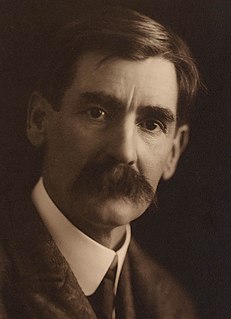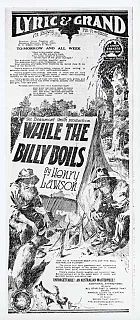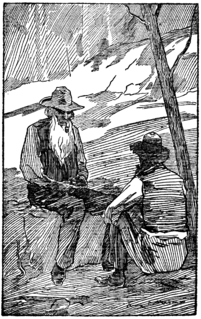Related Research Articles

Henry Archibald Hertzberg Lawson was an Australian writer and bush poet. Along with his contemporary Banjo Paterson, Lawson is among the best-known Australian poets and fiction writers of the colonial period and is often called Australia's "greatest short story writer".

The Bulletin was an Australian magazine first published in Sydney on 31 January 1880. The publication's focus was politics and business, with some literary content, and editions were often accompanied by cartoons and other illustrations. The views promoted by the magazine varied across different editors and owners, with the publication consequently considered either on the left or right of the political spectrum at various stages in its history. The Bulletin was highly influential in Australian culture and politics until after the First World War, and was then noted for its nationalist, pro-labour, and pro-republican writing. It was revived as a modern news magazine in the 1960s as The Bulletin with Newsweek, and was Australia's longest running magazine publication until the final issue was published in January 2008.
Dorothy Auchterlonie was an English-born Australian academic, literary critic, poet and swimmer.
Australian literature is the written or literary work produced in the area or by the people of the Commonwealth of Australia and its preceding colonies. During its early Western history, Australia was a collection of British colonies, therefore, its recognised literary tradition begins with and is linked to the broader tradition of English literature. However, the narrative art of Australian writers has, since 1788, introduced the character of a new continent into literature—exploring such themes as Aboriginality, mateship, egalitarianism, democracy, national identity, migration, Australia's unique location and geography, the complexities of urban living, and "the beauty and the terror" of life in the Australian bush.
Dorothy Coade Hewett was an Australian feminist poet, novelist and playwright. She was also a member of the Communist Party for a period, though she clashed on many occasions with the party leadership. In recognition of her 20 volumes of published literature, she received the Order of Australia, among other honours.

Louisa Lawson was an Australian poet, writer, publisher, suffragist, and feminist. She was the mother of the poet and author Henry Lawson.
Kate Lilley is a contemporary Australian poet and academic.
The Grace Leven Prize for Poetry was an annual poetry award in Australia, given in the name of Grace Leven who died in 1922. It was established by William Baylebridge who "made a provision for an annual poetry prize in memory of 'my benefactress Grace Leven' and for the publication of his own work". Grace was his mother's half-sister.
Rusty Bugles was a controversial Australian play written by Sumner Locke Elliott in 1948. It toured extensively throughout Australia between 1948–1949 and was threatened with closure by the New South Wales Chief Secretary's Office for obscenity.
Coral Magnolia Lansbury was an Australian-born feminist writer and academic. Working in the United States from 1969 until her death, she became Distinguished Professor of English and Dean of Graduate Studies at Rutgers University.

The Broken Melody is a 1938 Australian drama film directed by Ken G. Hall and starring Lloyd Hughes, based on a best-selling novel by F. J. Thwaites.
Robert Harris was an Australian poet, who also wrote as Orson Rattray Der.

While the Billy Boils is a 1921 Australian film from director Beaumont Smith which adapts several stories from Henry Lawson. It is considered a lost film.
Hills of Hate is a 1926 Australian silent film directed by Raymond Longford, based on the debut novel by E. V. Timms, who also did the screenplay. It is considered a lost film.
The Schippan Mystery is a 1984 Australian television film about the murder of Bertha Schippan in 1902. Directed by Di Drew, it was last of four telemovies called Verdict produced by the ABC dramatising real cases. It is the only one of the four cases set outside of New South Wales.

On the Track (1900) is a collection of short stories by Australian poet and author Henry Lawson. It was released in hardback by Angus and Robertson in 1900, and features one of the author's better known stories in "Bill, the Ventriloquial Rooster", as well as a number of lesser known works.

While the Billy Boils is a collection of short stories by the Australian writer Henry Lawson, published by Angus and Robertson in 1896. It includes "The Drover's Wife", "On the Edge of a Plain", and "The Union Buries Its Dead".
This article presents a list of the historical events and publications of Australian literature during 1975.
The First Joanna is a 1943 play by Dorothy Blewett.
Audrey Clarice Longbottom was an Australian poet.
References
- ↑ John Docker (2 September 1991). The Nervous Nineties: Australian Cultural Life in the 1890s. Oxford University Press. pp. 129–130. ISBN 978-0-19-553247-0.
- 1 2 3 4 Hewett, Dorothy (1967). "The journey of Henry Lawson". Australian Left Review. 1 (7): 28–34.
- 1 2 3 Kiernan, Brian (1997). "'From Mudgee Hills to London Town': A Critical Biography of Henry Lawson". Sydney Studies in Society and Culture. 17: 72–128.
- 1 2 3 4 5 Wilde, William H.; Hooton, Joy; Andrews, Barry (1991). "Steelman". The Oxford Companion to Australian Literature. South Melbourne, Australia: Oxford University Press. p. 647. ISBN 0195532732.
- ↑ Spurr, Barry; Cameron, Lloyd (2000). "Selected Stories by Henry Lawson". Standard English. Pascal Press. p. 120. ISBN 9781741250688.
- ↑ Lawson, Henry (1900). "An Oversight of Steelman's". On the Track. Angus and Robertson.
- ↑ "Steelman and Smith". AustLit: Discover Australian Stories. Retrieved 2020-07-07.
- ↑ Reis, Brian (1997). Australian Film: A Bibliography. Mansell. p. 250.
- ↑ Keating, Chris; Moran, Albert (2007). The A to Z of Australian Radio and Television. Plymouth, UK: Scarecrow Press. p. 55. ISBN 9780810868564.
- ↑ "Henry Lawson stories adapted for radio". The Australian Women's Weekly . National Library of Australia. February 12, 1944. Retrieved July 7, 2020.
- 1 2 Lawson, Henry (2013). Eggert, Paul (ed.). While the Billy Boils: The Original Newspaper Versions. Sydney, Australia: Sydney University Press. ISBN 9781743320112.
- ↑ "An Oversight of Steelman's". AustLit: Discover Australian Stories. Retrieved 2020-07-07.
- ↑ "How Steelman Told His Story". AustLit: Discover Australian Stories. Retrieved 2020-07-07.